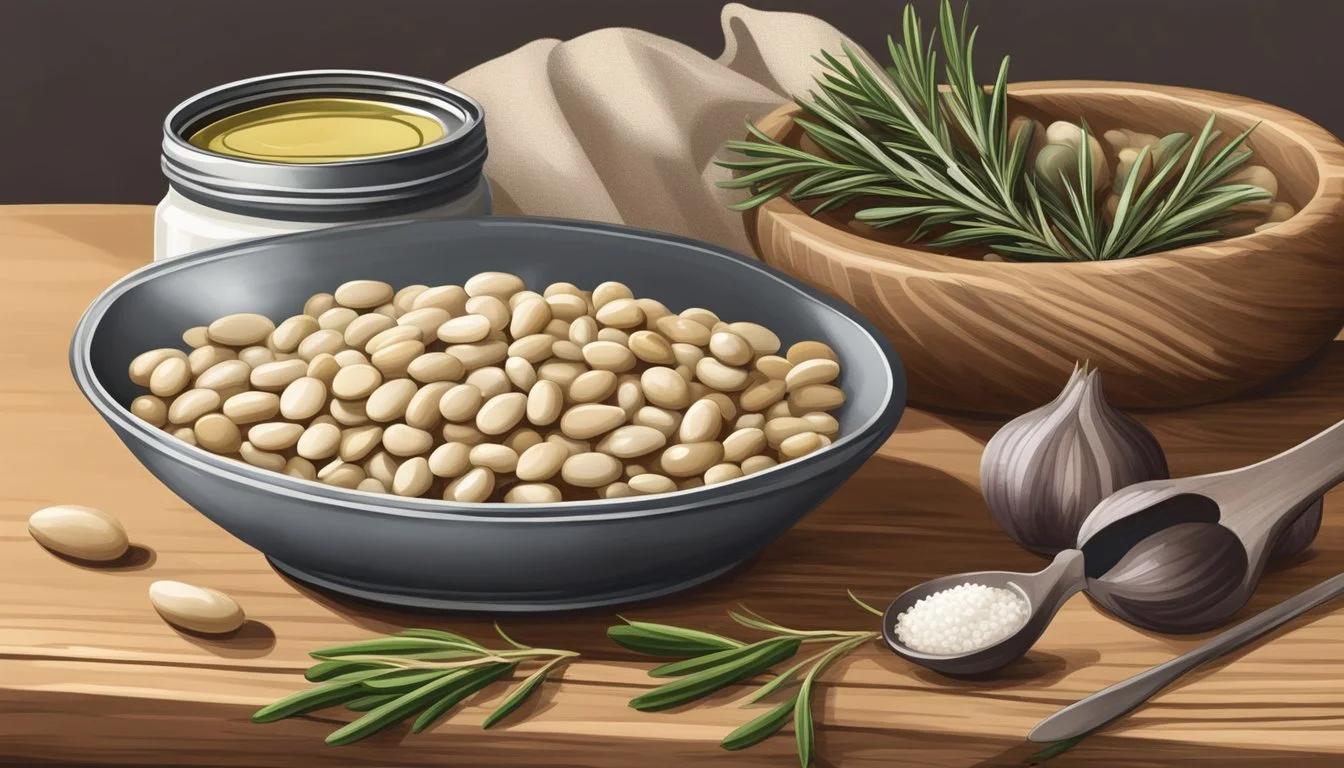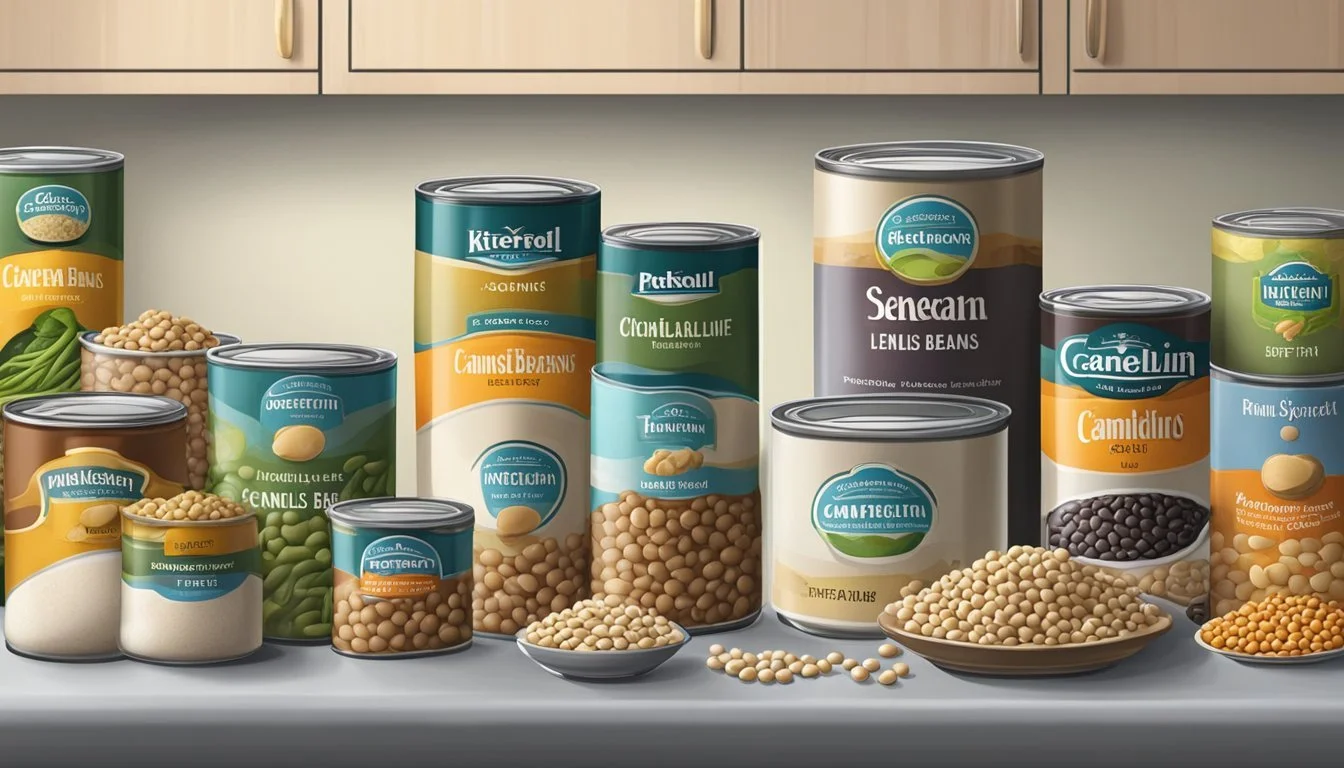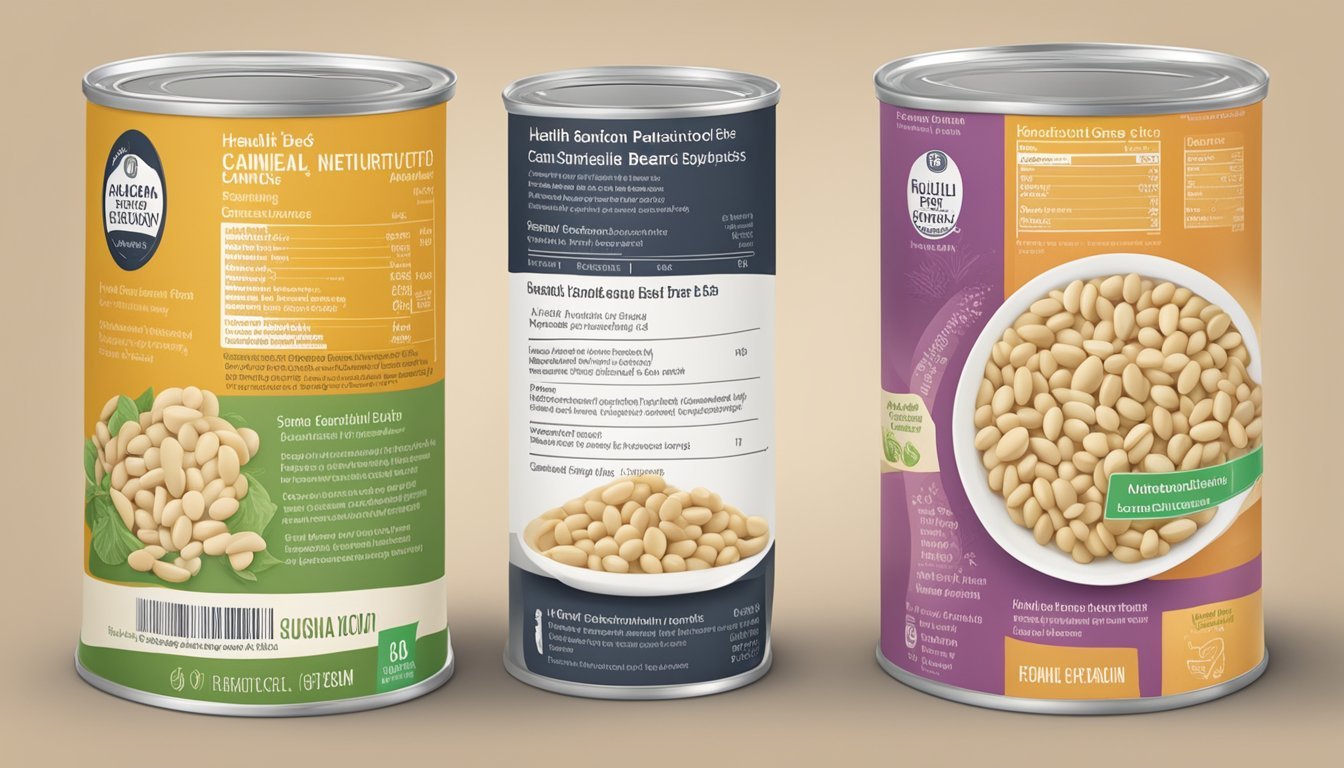Cannellini Beans Substitutes
Top Alternatives for Your Recipes
Cannellini beans, with their creamy texture and subtle flavor, are a staple in many Italian dishes. Yet, sometimes these versatile beans are not readily available, making it necessary to find a suitable substitute. Great Northern beans and red kidney beans are two of the best alternatives to cannellini beans, offering similar textures and flavors.
For those looking for a substitute that closely matches the taste and aesthetic of cannellini beans, Great Northern beans are an excellent choice. These beans have a mild taste and a similar texture, making them perfect for soups and stews. On the other hand, red kidney beans can be used in recipes where the color differences won't affect the presentation, providing a hearty and nutritious option.
Other viable alternatives include pinto beans, which work well in spicy dishes, and flageolet beans, which are often used in French cuisine. In many recipes, the specific type of bean might not drastically change the flavor but will influence the dish's color and texture. No matter which substitute is chosen, the dish can still maintain its integrity and deliciousness.
Understanding Cannellini Beans
Cannellini beans, also known as white kidney beans, are a staple in Italian cooking. They are prized for their high protein and fiber content, as well as their versatile texture and flavor that works well in numerous dishes.
Nutritional Value
Cannellini beans are rich in protein and fiber, making them an excellent addition to a balanced diet. A typical serving provides substantial amounts of plant-based protein, which is essential for muscle repair and growth. They are also high in dietary fiber, which supports digestive health and helps maintain a stable blood sugar level.
These beans contain vitamins and minerals such as iron, magnesium, and potassium. Their low fat and cholesterol-free profile make them a heart-healthy choice. Diabetic-friendly and minimally processed, cannellini beans contribute to a well-rounded, nutritious diet.
Culinary Uses
Cannellini beans are highly versatile, appearing in a range of culinary applications. Their mild flavor and creamy texture make them suitable for dishes like soups, stews, and salads. In Italian cuisine, they are a key ingredient in dishes like minestrone and pasta e fagioli.
These beans are also excellent in vegetarian recipes, serving as a protein alternative in casseroles and side dishes. Mash them into spreads or dips, or incorporate them into chili for varying textures without overpowering other flavors. Cannellini beans are adaptable to both hot and cold dishes, enhancing their utility in the kitchen.
Texture and Flavor
Cannellini beans have a creamy texture that blends well in dishes without becoming mushy. Their smooth skin and tender interior provide a pleasant mouthfeel. Unlike other beans, they maintain their form during cooking, making them perfect for dishes that require long simmering.
Their flavor is mild and somewhat nutty, which allows them to complement rather than overpower other ingredients. This subtle taste makes them a favorite for dishes that require a balance of flavors, such as light soups and salads. Whether used whole or mashed, their texture and flavor profile make them a versatile and valuable ingredient in various recipes.
Top Cannellini Bean Substitutes
Several beans can serve as highly effective substitutes for cannellini beans due to their similar texture, flavor, and nutritional profiles. Some of the top alternatives include Great Northern beans, Navy beans, and Kidney beans, each bringing unique characteristics to various dishes.
Great Northern Beans
Great Northern beans are an excellent substitute for cannellini beans. They are slightly smaller and have a mild, delicate flavor, making them suitable for many recipes where cannellini beans are used. These beans hold their shape well after cooking, making them ideal for soups, stews, and casseroles.
They are highly nutritious, offering a good amount of protein, fiber, and essential minerals like iron and magnesium. Their firm texture allows them to absorb flavors from other ingredients wonderfully, ensuring a balanced and satisfying dish.
Navy Beans
Navy beans are another great substitute. They are small, white beans with a creamy texture and a slightly nutty taste. These beans work well in dishes where a smooth consistency is desired, such as purees, soups, and baked beans.
Navy beans are packed with nutrients including protein, fiber, folate, and manganese. Their ability to blend seamlessly into various recipes while maintaining their soft texture makes them a versatile choice for replacing cannellini beans, especially in hearty, comforting meals.
Kidney Beans
Kidney beans can also be used as a substitute for cannellini beans. They are larger and come in a dark red or light red color, providing a different visual appeal. Kidney beans have a slightly firmer texture compared to cannellini beans, making them suitable for chili, salads, and robust stews.
These beans are rich in protein, fiber, and several vitamins and minerals, such as folate and magnesium. Their distinct taste adds depth to dishes, and their ability to maintain firmness even after extended cooking makes them a dependable option in recipes requiring a hearty bean component.
Substitutes Based on Dish Types
Cannellini beans have a mild flavor and creamy texture, making them versatile for a variety of dishes. Depending on the culinary application, different beans may serve as better substitutes.
For Salads and Lighter Fare
Navy beans work well as a cannellini beans substitute in salads. They are small, white beans with a similar nutty flavor and tender texture. Great northern beans are also ideal for this purpose, offering a slightly larger size but maintaining a comparable taste and texture.
Chickpeas can be another option. Though they have a firmer texture, their nutty flavor complements many salad ingredients.
Adzuki beans can add a unique twist with their firmer bite and slightly sweet flavor, suitable for lighter dishes that benefit from a distinct texture.
For Hearty Soups and Stews
Great northern beans are excellent for soups and stews. Their slightly larger size and similar texture to cannellini beans help them hold up well under long cooking times. They are particularly effective in soups like minestrone due to their ability to absorb flavors while maintaining shape.
Pinto beans can also serve as a good alternative. They work best in spicier, robust soups and stews where their unique taste can stand out.
Navy beans perform admirably in hearty soups thanks to their creamy texture, which enriches dishes like baked beans or bean stews.
For Baking and Casseroles
In casseroles, great northern beans are about the best substitute you can find. Their firm texture holds up well without turning mushy.
Pinto beans work well in baked bean dishes. They provide an earthy flavor and pleasant texture that complement baked goods and casseroles.
Chickpeas are suitable for baking applications where a firmer texture is desirable. They are also a great source of protein like cannellini beans.
Tables can summarize these substitutes for quick reference:
Recipe Type Best Substitutes Salads Navy beans, Great northern beans, Chickpeas, Adzuki beans Hearty Soups & Stews Great northern beans, Pinto beans, Navy beans Baking & Casseroles Great northern beans, Pinto beans, Chickpeas
Alternative Substitutes for Specific Flavors and Textures
Cannellini beans are known for their smooth texture and mild flavor. When looking for substitutes, it is helpful to consider other beans that can offer similar qualities, whether it be a nutty flavor, earthy flavor, or a smooth, soft texture.
Beans with a Nutty Flavor
Navy beans are a top choice due to their similar texture and slightly nutty flavor. These small, white beans blend well in soups and stews, maintaining a subtle but distinct taste. Cranberry beans (also known as Borlotti beans) provide a nutty flavor with a creamy texture, ideal for Italian dishes and hearty soups.
For a unique twist, chickpeas are an excellent option. They deliver a robust nutty flavor and can be used in a variety of dishes, from hummus to stews.
Beans with an Earthy Flavor
Pinto beans are a great substitute if you need a bean with an earthy undertone. Common in Mexican cuisine, they offer a unique taste that complements spicy and savory dishes well. Lima beans also provide a pleasantly earthy flavor, working well in stews and side dishes.
Fava beans, or broad beans, have a rich, earthy flavor with a slightly bitter edge. They can be used to add depth to soups, salads, and casseroles, contributing not only flavor but also texture.
Beans with a Smooth or Soft Texture
For a smooth, soft texture similar to cannellini beans, Great Northern beans are an excellent choice. They maintain their shape during cooking but become tender, making them suitable for many recipes including casseroles and soups.
Tofu can also be used as an alternative for a soft texture, especially in vegetarian dishes. It's versatile and absorbs flavors well. Another good substitute is butter beans (mature lima beans), which provide a buttery soft texture and are excellent in soups and pureed into spreads.
Using these alternatives allows for flexibility in recipes while maintaining the desired taste and texture profiles.
Legume Alternatives to Cannellini Beans
Various legumes can serve as effective substitutes for cannellini beans, given their similar textures and flavors. This section discusses chickpeas, lentils, and black-eyed peas as potential alternatives, noting their unique characteristics and best uses in recipes.
Chickpeas and Garbanzo Beans
Chickpeas, also known as garbanzo beans, provide a hearty and nutty flavor. They hold their shape well during cooking, making them a suitable replacement in salads and stews. Unlike cannellini beans, chickpeas have a slightly grainy texture and a rounder shape, adding a different tactile experience to dishes.
Nutritional Aspect: Rich in protein and fiber, chickpeas offer health benefits while closely matching the nutritional profile of cannellini beans.
Usage: Given their firmness, chickpeas work well in dishes requiring beans to maintain their structure, such as hummus and certain Mediterranean dishes. They are also versatile enough to complement both spicy and mild flavors effectively.
Lentils as a Quick Alternative
Lentils, particularly red or green varieties, cook faster than other legumes, making them a quick alternative. They have a slightly peppery taste and can absorb flavors well, which makes them a flexible ingredient for many recipes. While they are smaller and softer compared to cannellini beans, they still provide a satisfying bite.
Nutritional Aspect: Lentils are high in protein and iron, making them beneficial for various dietary needs.
Usage: Their rapid cooking time is advantageous for soups, stews, and salads. Lentils are also excellent in thickening dishes due to their ability to break down during cooking, offering a different textural dynamic than whole beans.
Using Black-Eyed Peas
Black-eyed peas, known for their slightly earthy flavor, can be a practical substitute for cannellini beans. Though traditionally used in Southern and African cuisines, their unique taste can diversify many recipes. These beans have a softer texture and a characteristic "eye" on their surface.
Nutritional Aspect: Black-eyed peas are nutrient-dense, offering significant amounts of folate, magnesium, and fiber.
Usage: Ideal for slow-cooked dishes, black-eyed peas complement spices and herbs well. They are particularly good in hearty soups and casseroles, where their flavor can stand out without being overpowering.
Unique Substitutes in Regional Cooking
Different cultures utilize unique types of beans as substitutes for cannellini beans, each bringing distinctive flavors and textures to culinary dishes. Below are some notable examples from Europe and South America.
European Varieties
Borlotti Beans are popular in Italian cuisine and can replace cannellini beans due to their creamy texture and nutty flavor. Frequently used in pasta e fagioli and rustic stews, they add a rich color and depth.
Flageolets, often called the "caviar of beans," are a staple in French cooking. These small, tender beans have a delicate flavor that complements dishes like cassoulet and spring vegetable ragouts. They are lighter in color and offer a subtle alternative in recipes calling for cannellini beans.
South American Beans
Adzuki Beans, though primarily associated with Asian cuisines, find their place in South American dishes as well. These small, red beans bring a mild sweetness and firm texture, useful in desserts and savory dishes alike.
Anasazi Beans are native to the southwestern United States and parts of South America. They offer a unique, rich taste with a hint of sweetness. Popular in Argentine stews and Peruvian soups, they cook faster than many other beans, making them convenient substitutes.
Utilizing Fresh and Dried Substitutes
Exploring options for replacing cannellini beans, both fresh and dried, can lead to discovering new flavors and textures. Knowing how to work with each type is essential for achieving the best results in various dishes.
Fresh Bean Options
Fresh bean alternatives to cannellini beans offer a robust flavor profile and texture. Great Northern beans are a popular choice due to their similar taste and slightly tougher texture. These beans can be integrated seamlessly into soups, stews, and casseroles.
Another viable option is pinto beans, known for their earthy flavor and versatility in spicy dishes like chili and burritos. They add a unique visual element with their darker color and occasional spots.
Navy beans also present a useful substitution, excelling in baked beans and hearty soups. These beans are small, white, and slightly creamy, making them excellent for dishes requiring a smooth texture.
Dried Bean Preparation
Using dried bean substitutes necessitates proper preparation to unlock their full potential. Dried cannellini beans must be soaked overnight or quick-soaked before cooking to reduce cooking time and achieve desired tenderness.
Red kidney beans can be an interesting substitute, especially in recipes where the color does not impact the dish significantly. They require soaking and careful cooking to avoid toxicity.
Experimentation with black beans can also be fruitful in various recipes. These beans need a longer soak and cooking time but provide a rich, dense flavor suitable for robust dishes like stews and chilis.
Regardless of the type, ensuring beans are adequately soaked and cooked guarantees they will blend well with other ingredients and enhance the dish's overall taste and texture.
Health Considerations When Choosing Substitutes
When selecting substitutes for cannellini beans, it is crucial to consider the nutritional profile, particularly the levels of dietary fiber and protein, as well as the suitability for vegan and vegetarian diets.
Dietary Fiber and Protein Content
Cannellini beans are known for their high dietary fiber and significant protein content. Substitute beans should ideally match these characteristics to maintain nutritional balance.
Fiber: Beans like black beans and fava beans offer comparable fiber content. Black beans provide around 15 grams of fiber per cup, supporting digestive health and satiety.
Protein: In terms of protein, pinto beans and fava beans are strong candidates. Pinto beans deliver approximately 15 grams of protein per cup, crucial for muscle maintenance and repair.
Vegan and Vegetarian Considerations
Selecting bean substitutes suitable for vegan and vegetarian diets ensures that those avoiding animal products still receive necessary nutrients.
Vegan Options: Chickpeas and kidney beans are excellent choices. Both are plant-based and offer substantial protein and fiber. Chickpeas, for instance, have around 14.5 grams of protein per cup.
Vegetarian Flexibility: Vegetarians can utilize a broader range of legumes. Lentils and black beans are ideal due to their versatility and nutrient density, which include high amounts of iron and fiber beneficial for vegetarian diets.






